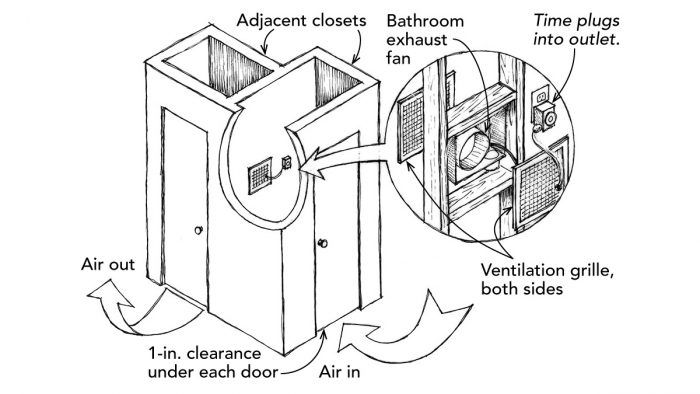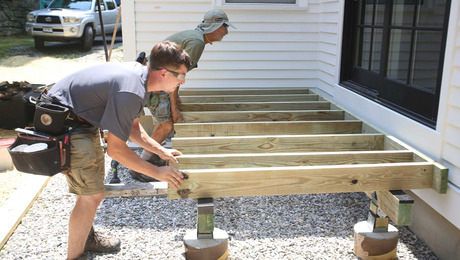Venting a Musty Closet
Eliminate that musty closet smell by adding an affordable and easy-to-install vent.

We have a small basement divided into a laundry room and a full bath. Each space has a small finished closet; the closets share a common wall. The basement is about halfway underground, with an exterior walkout and several windows in the laundry room.
An open stair services the basement from the kitchen, and a portable dehumidifier keeps the relative coolness of the basement from condensing moist Georgia summertime air. The laundry room and the bathroom stay dry and pleasant, but the closets, being closed, get musty. Leaving their doors open is inconvenient and unsightly. The solution I came up with cost less than $100 and took just a couple of hours to install.
The Process
As shown in the drawing, I cut an approximately 11-in.-sq. hole through both sides of the common wall between the two closets. The hole is between the studs, about 5 ft. above the floor. I then inserted a couple of 141/2-in. 2×4 blocks and mounted them horizontally top and bottom between the studs, screwing through the drywall to create a closed passageway from closet to closet.
After that, I mounted an inexpensive bathroom exhaust fan into the framed opening, and I attached a 6-ft.-long electrical plug and cord to the fan through a hole drilled in the grille. Next, I installed a receptacle to the side of the fan and plugged a common 24-hour vacation timer into the outlet. The fan plugs into the timer, which I adjusted to turn its circuit on two hours a day, late at night. Then I trimmed the bottoms of each closet door to give a full inch of clearance from the floor.
In operation, the fan turns on at midnight for two hours and draws air into closet #1, under the door, from the laundry room. The air is exhausted into closet #2 and then flows under its door to the bathroom, which has a door to the laundry room.
The Results
The effect could not be more dramatic. Although closed, the closets are now so odor-free that my wife can store linens and such with no worry about mildew or mustiness. After a few months, we replaced the mechanical vacation timer with a nifty digital one; we found that our cheapie timer was often audible from the room above. I’ve also installed similar systems for a couple of clients, and they are pleased as well.
— Forrest McCanless; Oxford, GA
From Fine Homebuilding #206
RELATED STORIES
- The Well-Designed Walk-In Closet
- Too Much Humidity From Oversize Air Conditioner
- A Custom Closet Remodel
Got a Tip?
Do you have any great tips like this one on venting a musty closet on a budget? Share your methods, tricks, and jigs with other readers. Tag them @FineHomebuilding on social, email them to us at [email protected], or upload them to FineHomebuilding.com/reader-tips. We’ll pay for any we publish.






























View Comments
I would recommend adding a motor speed control to adjust the speed down and run it 24/7. You would not need the timer.